In 1925, Palekh artists won the Grand Prix at the international exhibition in Paris. From that time on, they became world famous, and their pictures with unusual paintings enjoyed incredible popularity. Today, Palekh painting is a world-famous type of artistic fine art of the Russian people.
History of the origin of the industry
Palekh painting, pictures in lacquer miniature, has gained wide popularity throughout the world. However, Initially, this art was a craft of ancient Russian icon painting. It originated in the small village of Palekh, next to the city of Shui. The settlement in the 1980-1990s was small and consisted of 1 street. Local residents before the Revolution were mainly icon painters.
The fame of local craftsmen attracted other residents of the region, which is why rich fairs were held here on major church holidays. The most famous Orthodox icons, "Akathists", were painted in this place, which are currently transferred to the State Museum of Palekh Art for safekeeping.
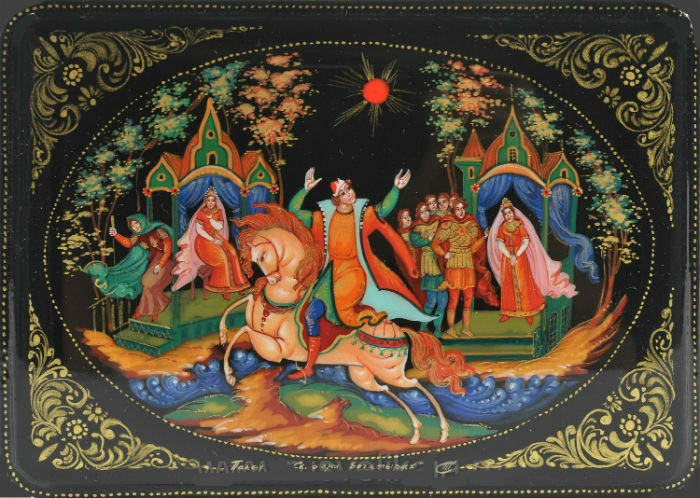
In the 1990s, there were a large number of icon painting workshops in this village. Many artists saw this craft as a good source of income, and some people treated painting as an art, conveying every line to the miniature.
The most famous Palekh painting was the small-scale writing. This type of painting on a church theme contained 30 figures of saints and stamps of the twelve great feasts. For example, in the center of the painting they wrote "Resurrection of Christ", and along the edges they applied 360 Mothers of God.
This type of Palekh painting was also called minaia. The traditions of fine writing were passed down from generation to generation, and after the revolution they managed to adapt the craft to new requirements.
If you look at the works of icon painters from Palekh, you can see a clear reference to ancient Russian features of painting. It is a fusion of two styles: Stroganov and Novgorod. Their artistic techniques and methods are clearly visible in the works.
In the 17th century, Palekh developed its own style, which received special expression in the 18th century. The best works of that time demonstrate the true mastery of Palekh icon painters.
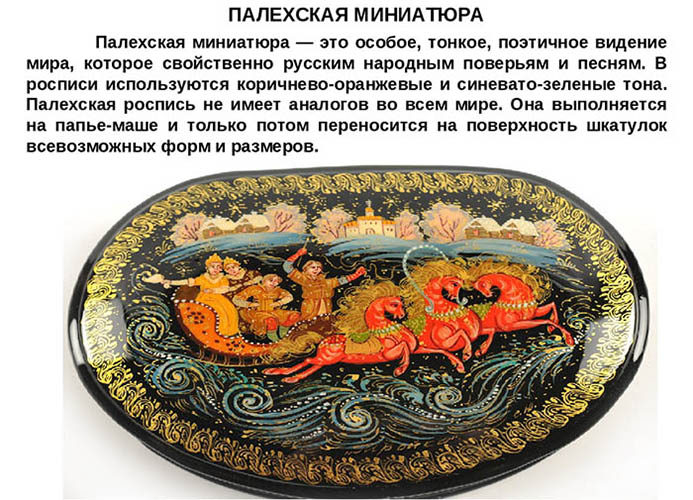
For example, if you look at the icon "Joy of All Who Sorrow", painted at the end of the 17th century, you can see in it a significant complication of painting, its detailing. The light tone of the faces and beautifully decorated clothing are united by a common tone.
Subsequent works from the end of the 17th century already characterize the established Palekh style with its complex construction of stamps, golden-reddish coloring and multi-figure. Examples of this are the Akathists to the Savior and the Mother of God, as well as the "Akathist to St. Nicholas the Wonderworker".
At the end of the 18th century, a new type of Palekh painting was developed in Palekh – fryazhsky. It differs from the usual icon painting craft. Initially, this type of art originated in Moscow, and then spread beyond its borders. This style had a huge influence on Palekh painting, dividing it into 2 directions:
| Type of Palekh Frazhsky script | Description |
| First | The icons were painted on a gold background. The crowns and borders were covered with the same color. Then, everything was subjected to embossing, which was then painted with pigment for enamel. The literal writing in large icons was painted with oil paints, and egg paints were used for decoration. All the details of the landscape were painted as close to reality as possible. The works were distinguished by a delicate palette of variegated shades and the shine of gold. |
| Second | The icons were painted on a blue background, close to the color of the sky. The landscapes were realistic, with gilded and embossed borders and crowns. When the academic painting trend came to the village of Palekh (late 19th century), local masters began to imitate it. Icon painting was done by copying the illustrations of Piscator, Shnor, Nef, Sorokin, Bruga, Shokirev. It is worth noting that the masters qualitatively adopted this style, and performed them under the name of Fryazhskaya painting. In the same period, the technology of artistic painting with oil paints began to be introduced. |
Palekh painting, iconographic pictures, remain flat and decorative. Human faces are elongated, and their clothes are made according to ancient traditions of artistic craft. However, the depicted birds, trees and animals are already close to nature. The chamber painting is close to Stroganov in its features.
However, having created their own special style, Palekh masters continue to work in the old directions: Stroganov and Novgorod. They preserved their own type of icon painting, and did not even lose its artistic features in the 19th-20th centuries.
Palekh painting, pictures and ornaments were called kulak in Soviet times. This craft survived until the 21st century due to the authorities' interest in exporting goods with such ornaments.
At that time, Russian oil and other minerals were not in demand abroad, and therefore folk art items were exported in large quantities. Therefore, the authorities could not prohibit something that brought good economic profit.
However, the Soviet government constantly tried to eradicate the original idea of such art. Under various pretexts, artisans were asked to remove the religious subtext of the pictures and replace it with earthly images.
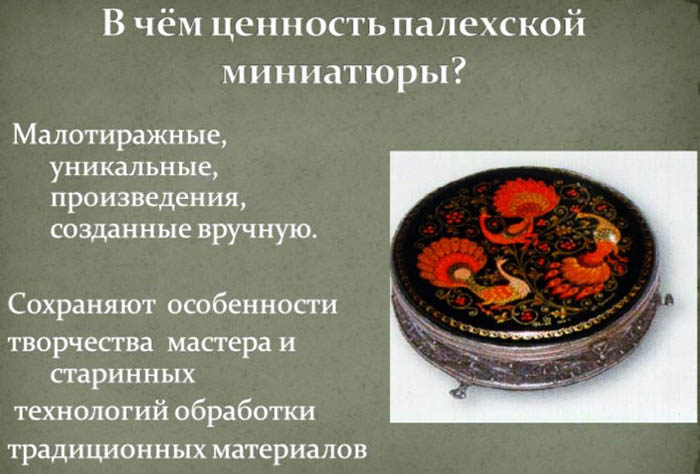
Later, public schools for Palekh painting were created. Currently, the number of graduates of the Palekh public art school exceeds 600 people. This means that every 6th resident of this village is theoretically an artist.
Features of painting
Palekh painting, pictures of an iconographic nature, were created by several masters.
The division of labor was as follows:
- The carpenter cut the cypress wood into bars, from which he then formed a blank for the future icon.
- The primer prepared the surface for painting.
- The artist was painting a picture.
- The gilder covered the crowns and background with gold plating.
- The embosser made the embossing of the border of the icon and the crown of the saint.
- The master of pre-personal writing painted clothing, architecture and landscapes.
- The master painter painted the face of the saint and other naked parts of the body.
- The signature was put by a specific person who gave the name to the icon.
- The master covered the finished image with drying oil.
In addition, the peculiarity of the painting is the artistic highlighting of even the smallest compositions of the image. They seem to tell the story laid down by the master.
This direction requires special attention, because detailing the drawing, highlighting its miniature features is not an easy task. It is necessary to convey all the subtleties of the characters and the landscape.
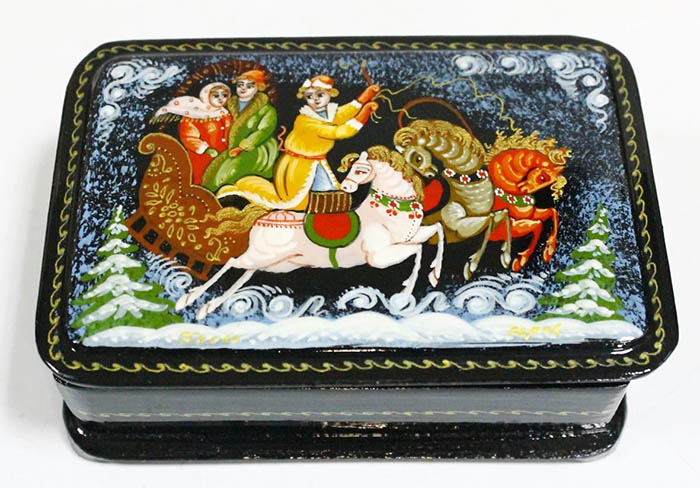
The peculiarities of Palekh painting are its traditional technique, which is conventionally divided into the following groups:
- Composition with 3 figures, depicted up to the shoulders.
- An image with people depicted from the waist up. The number of figures is 3 people.
- Composition with 3 figures of people depicted in their full height.
- Icons with a description of the life of a saint, who became the epicenter of the canvas.
- Canvases with the image of a saint, around which, in several tiers, stamps were written, inside which a plot was embedded.
- Compositions with 1 plot, less complex. They were placed in a group in the center or in several rows.
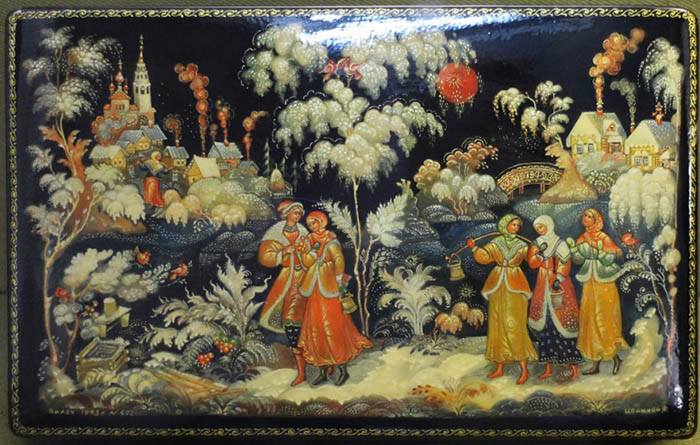
All icon painting schools have one common feature: the principle of constructing painting on a plane and the conventionality of perspective. These characteristics were also developed in Palekh painting.
The features of this craft can be seen in the following examples:
- Miniature by I. A. Chelyshev "Blizzard". This work clearly shows the character of Palekh painting, as well as the creative traditional method of constructing the composition. The work is done on the lid of the box and decorates its flat part well. All the details are organically located and clearly expressed.
- Miniature by I. M. Bakanov "Shepherd". This work vividly reflects the decorative construction of the drawing, despite the fact that all additional scenes seem to have been removed. However, the figures of animals, reapers and shepherdess are drawn very realistically.
- Miniature by I. I. Golikov "Battle". The surface of the box and its conventional background are decorated with painting. The decorative elements are expressed by a special arrangement of the heroes in an ellipse on a rectangular shape. All compositional details are carefully worked out, due to which the drawing looks like a continuous ornamental pattern.
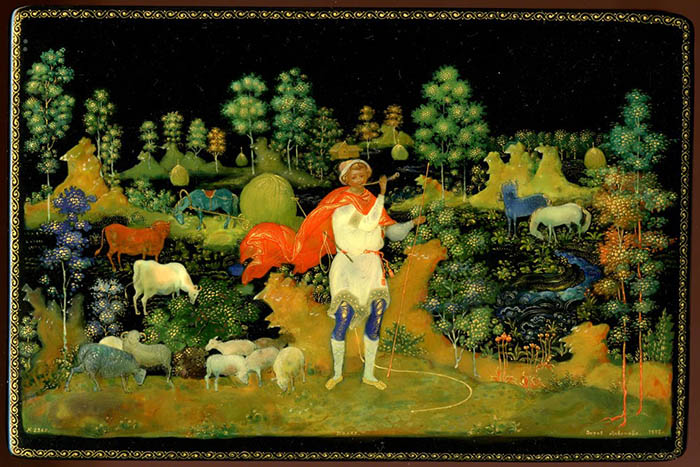
Distinctive features of Palekh painting also include:
- A large number of detailed elements of the painting.
- The overall tone of the painting is soft.
- A variety of rainbow shades.
- Light, wide gaps of paint. The highlight is sharp and very thin, white, often in a “half-feather” of gold.
- Slightly elongated figures of the characters, as in the Stroganov style.
- The mountains are inscribed with pointed slopes.
- The shadows are painted using the multi-tonal technique.
- Exact copying of some elements. For example, tree leaves.
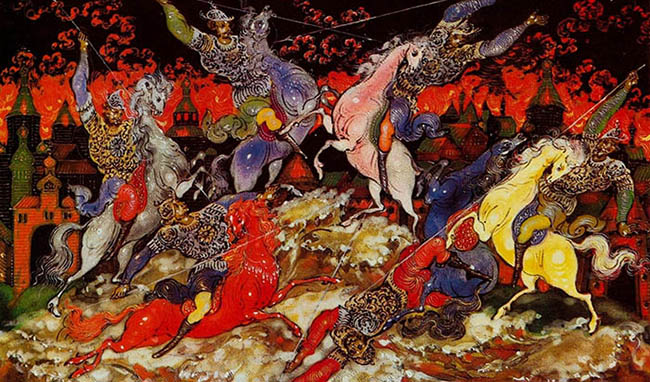
The technique of Palekh painting is complicated by a large number of details in the composition, light and shadow fusions. For miniature works, a sketch was made on a sheet of paper, drawing all the smallest details on it. Then this image was pricked with a needle.
Afterwards, a powder was made from it, from which a carbon imprint was created, on which painting was subsequently done. Palekh miniatures were loved by Russian writers. Therefore, they were very often used as illustrations for works.
Painting colors
Icons in the Palekh painting technique were painted on a light yellow background. The main color was applied immediately, sometimes it matched the shade of the primer. If the coating was levkas-chalk, then no background was applied, the surface could only be slightly gilded.
The painting was created directly on the ground layer, on which the pigment lay lightly and airily. The buildings, figures of people and animals, and the landscape were covered with color. Soft, transparent tones were used. After that, the painting was done with dark colors.
She performed the following work:
- They made the outline of mountains, cliffs and ledges.
- They outlined the trees, their trunks and leaves.
- They painted the water. They applied paints with soft, sparse strokes so that between the lines they could draw 2 light strokes that formed waves.

The painting of buildings began with their outlines, and then moved on to the ornamentation.
To give the image volume, we made shadows of the objects:
- Darkened parts of the clothing in the middle of the fold lines.
- On the mountain ranges, the ledges and other sides were darkened.
- Shadows were painted on trees. Most often, they were applied to the ends of leaves.
All this was applied with almost transparent dark paint. In modern Palekh painting, a large number of colors were used.
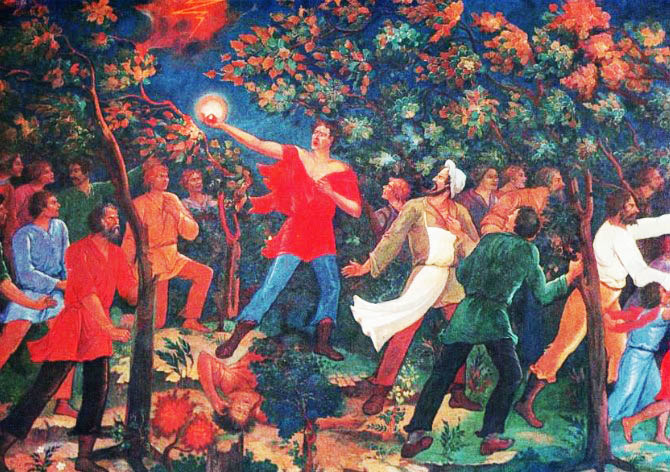
The following works confirm this:
- Fragment of the wall painting "Gorky's Room" in the Leningrad Palace of Pioneers named after A.A. Zhdanov. The work was done by N.M. Zinoviev, 1936.
- “Danko”, painting by A.G. Bakanova and D.N. Butorina.
- "The Tale of the Fisherman and the Fish" by A.V. Kotukhip and I.I. Zubkov.

All the colours used in Palekh painting are distinguished by the brightness of their colours, the multitude of shades and their saturation.
Elements and patterns of painting
Palekh painting contains the following patterns and elements in its pictures:
- Ornaments of spiral, horizontal and curved lines.
- Trees in Novgorod (15th century) and Stroganov (17th century) styles.
- Mountains.
- Chambers in Novgorod and Stroganov styles.
- Waves.
- Landscapes.
- Horses.
- Characters.
- Faces of saints.
Palekh painting can depict entire storylines, which include characters, animals and beautiful landscapes. Thanks to the ability to combine all the elements, artists can create various stories even in miniature.
Technique of creating a pattern
First, the composition is created with a pencil on paper. Then, the sheet serves as a sketch throughout the entire miniature painting lesson. The image is transferred to the upper part of the object to be painted. Before this, the varnish coating of the plane is rubbed with crushed pumice until it is matte.
After this, the drawing is rubbed with dry chalk powder or whitewash using a finger. Afterwards, the image on the paper is applied to the surface of the object and transferred using a scribe. Be sure to pay attention to the contours of all objects. To prevent the paper from sliding on the surface, its edges can be glued.
When the paper sheet is removed, a clear imprint will remain on the flat part of the object. Excess powder must be brushed off without affecting the outline of the drawing. This completes stage 1 of the work on the Palekh miniature.

At the 2nd stage, preparation with white is carried out. It is necessary to increase the strength of the paint pigment on the varnish coating. It is a proven fact that black varnish seems to reduce saturation, and preparation with white saves it from this.
During the work, it is necessary to think about where to place dark and bright tones. Based on this, preparation is carried out with whitewash. For example, the foliage of trees in the 1st plane, bright clothes or light mountain ledges are covered with thick whitewash. Shades of medium saturation are not prepared so thickly, but darker pigments are covered with whitewash of a watery consistency.
If there are very dark areas in the drawing (for example, areas between waves, black clothing, interior details of buildings), then they are not covered with white at all.
Correct execution of work at this stage will allow the miniature to obtain a finished look, made using the light silhouette technique. Such paintings, without their further processing, can be seen in the Palekh painting museums. The master I. I. Golikov painted in this technique.
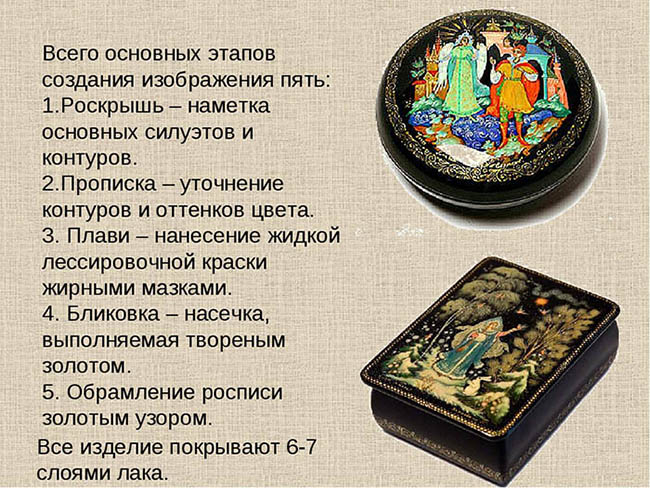
At the third stage, color pigments are applied, the so-called paint roskrush. For this, a medium-sharp brush is used. The palette of colors can be mixed into an infinite number of shades. If the tone needs to be applied in bulk, then a thick consistency is used. For a more transparent shade, it is applied as transparently as possible, in a diluted form.
At the fourth stage, they begin to paint. To do this, they draw each element and contour in a dark tone on the previously drawn roskryshka. On the trees, they make an edging of the trunks and branches, draw the shape of the leaf blades. On the mountain ranges, they highlight the ledges, on the water surface they draw the play of waves.
If there is a human figure on the miniature, then every fold of clothing is drawn on it. If there are animals, their contours are highlighted. When painting, smooth, soft lines of varying thickness are used. Even the pressure of the brush is adjusted.
It is important to make sure that the painting merges with the luxuriance, and does not look like 2 different elements of the composition. At stage 5, the shadow of each detail of the drawing is drawn. The fusion is done with a medium-sharp brush so as to reveal the volume. It is worth considering that the highlighting of the shadow and light parts is not necessarily done with paint similar to the luxuriance. This rule primarily concerns the landscape.
For example, if the water surface is painted with cobalt, then to emphasize its shadow parts or areas between the waves, fill this space with ultramarine. The lightest part of the water is covered with emerald green with white. Thanks to this, a shimmer of different shades occurs.

At stage 6, the finishing of the person's body, elements of his clothing and other details of the landscape are completed. This will give all the lines of the miniature a finished look. In some places, gaps are made on the creases in the clothing, most of which are made of gold. At stage 7, the drawing of the person's head and naked parts of the body is completed.
Beginners in this craft need to start with the simplest basics of Palekh painting. For example, to begin with, it is worth learning to copy the simplest ornament, including inclined, horizontal and curved lines.
The purpose of such a lesson will be to study the ornament, to fill the hand to draw lines of different shapes with a sharp brush. It will also allow to get an idea of the features drawn with different force. The execution algorithm is created using auxiliary lines.
If everything is done correctly, the final version of the drawing will be as follows:

The technique of its creation:
- Determine the location of the pattern on the paper.
- Using a ruler, draw the lower and upper auxiliary horizontal lines.
- On the right side, between the 2 horizontal lines, a vertical line is drawn and divided into 5 equal parts.
- 5 equal parts are adjusted along horizontal lines and marked with dots.
- Light, auxiliary lines are drawn through the marked points: horizontal and vertical. Thanks to this, the area for the drawing should be divided into squares.
- The ornament is drawn according to the auxiliary divisions.
- By hand, draw the framing horizontal lines with a pencil, and then draw a zigzag middle line (from the 2nd division: from the bottom and top, and through the 3rd division horizontally).
- Between the zigzags, spirals are drawn, starting from the inclined lines. Thanks to this, the curved lines seem to grow out of the inclined ones.
- The finished ornament is painted.
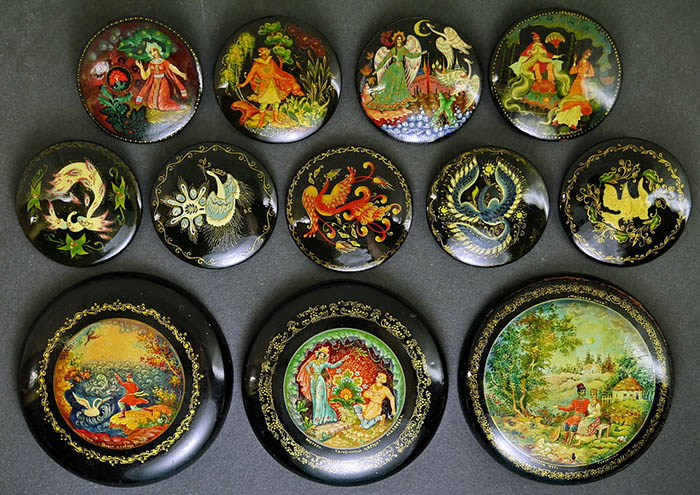
You can master Palekh painting thanks to the extensive instructions of N.M. Zinoviev. His manual is composed from the simplest elements to the most complex patterns.
Palekh painting, which has survived to the present day, is in demand among tourists. Its bright pictures decorate boxes and other interior items. You can learn this craft at an art school. Experienced teachers will introduce you to the basic techniques of painting and teach you how to use all the tools of this craft.
Video about Palekh painting
Master class on painting Palekh miniatures:
